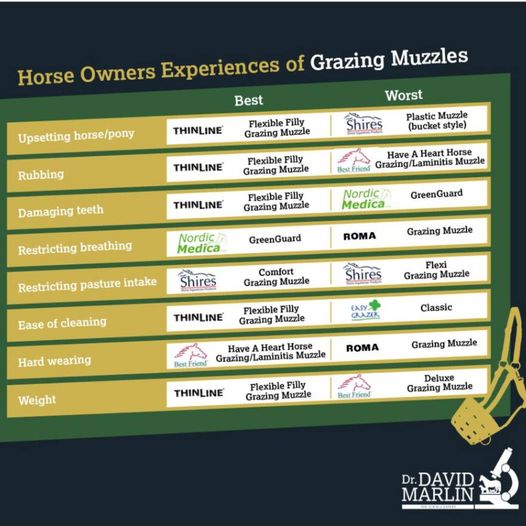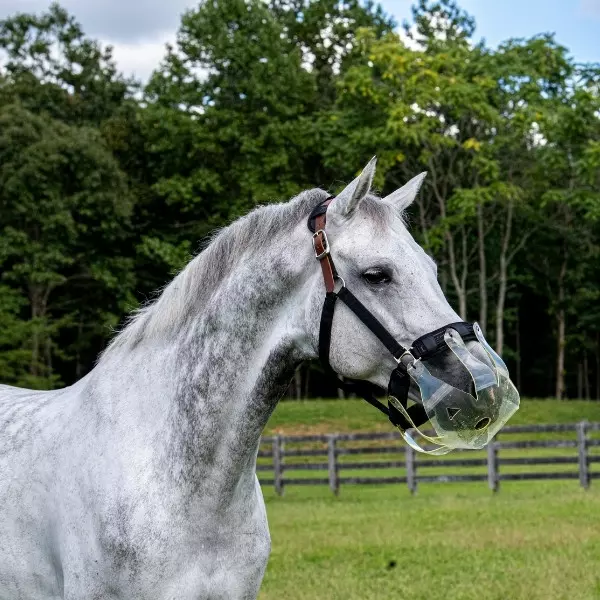Dr. David Marlin’s article, published on April 14, 2023, presents the results of a comprehensive survey on the use of grazing muzzles for horses and ponies.
Horse owners often use grazing muzzles to manage weight and reduce the risk of laminitis, a condition affecting horses. The survey aimed to gather insights from horse owners on their experiences and perceptions regarding grazing muzzles’ effectiveness, safety, and impact.

Survey Methodology and Demographics
The survey was conducted online through Dr. David Marlin’s Facebook page and several Facebook groups. It remained open for eight days, attracting 1082 responses. Most of the respondents were current (41%) or former (53%) users of grazing muzzles, while 7% had never used them.
Reasons for Not Using Grazing Muzzles
Respondents who had never used grazing muzzles cited several reasons, the most prominent being:
- Concerns about causing frustration (65%).
- Lack of necessity (33%).
- Fear of causing injury (30%).
Primary Uses of Grazing Muzzles
For those who used grazing muzzles, the primary reasons were:
- Weight management (89%).
- Management of Equine Metabolic Syndrome (EMS), Cushing’s, or Laminitis (77%).
- Prevention of colic (4%).
- Behavioral issues (1%).
- Polysaccharide Storage Myopathy (PSSM) management (1%).
Seasonal Usage Patterns
Most respondents used grazing muzzles during the spring and autumn, with 19% using them year-round.
Fit and Acceptance
- Fit: 27% reported a “very well” fit, and 43% a “well” fit.
- Acceptance: 36% of horses and ponies accepted the muzzle immediately, 32% within a few hours, and 17% over a few days. However, 12% never got used to it.
- Retention: 69% indicated the muzzle stayed on “very well” or “well.” However, 49% had to modify their purchased muzzles with electrical taping, sheepskin padding, or attaching to a field-safe halter.
Duration of Wear and Impact
- Most animals wore the muzzle for 6-12 hours per day.
- Annoyance or Upset: 41% reported no annoyance, while 36%, 15%, and 8% experienced slight, moderate, and severe reactions, respectively.
- Rubbing: 43% experienced no rubbing, whereas 37%, 16%, and 4% encountered slight, moderate, and severe rubbing, respectively.
- Teeth Damage: 83% saw no damage, but 11%, 4%, and 2% observed slight, moderate, and severe damage, respectively.
- Breathing Interference: 89% reported no interference.
- Pasture Intake Restriction: 98% acknowledged some level of intake restriction.
Variety and Evaluation of Grazing Muzzles
- The survey included 36 brands/models. However, only 13 of the 36 received ten or more ratings, which deemed a brand/model reliable to be included in the analysis.
- The top-rated muzzle was the Thinline Flexible Filly Grazing Muzzle (83% overall score). It excelled in 5 out of 8 categories and had the highest proportion of 10/10 ratings (33%), easily outdistancing the other brands/models.
- The survey also evaluated cost-effectiveness. The EasyGrazer Classic (£150) was the most expensive muzzle, and the cheapest was the Shires Plastic Muzzle (£12). The Thinline Flexible Filly, though expensive (£80), offered high value for its cost.
Reasons The Flexible Filly Grazing Muzzle Out Performed The Others
Since its introduction in early 2019, the Flexible Filly Grazing Muzzle has gained wide acceptance among horse owners. Dr. Marlin’s survey results serve as confirmation.
When ThinLine first began developing the muzzle, their goal was to change the look and feel of traditional grazing muzzles altogether, to do away with the typical heavy, “cage-like” design that had been the norm. Their approach was two-fold – to create a safe, comfortable muzzle that would give owners peace of mind and not feel guilty putting on their horses.
The Flexible Filly Grazing Muzzle is the brainchild of several years of careful testing.
The highly pliable polymer material the muzzle is made of gives it a light, thin appearance that might be misleading regarding its durability. But in the words of one reviewer’s description, “the ThinLine is well made, sturdy, and FLEXIBLE but not so much that my horse can move it around to cheat eat.”
The lightweight polymer also explains why the Flexible Filly Muzzle scored highest (98%) in the survey’s weight category.
Needless to say, this supple material earned the Flexible Filly Muzzle bragging rights in the survey’s ‘Did Not Rub’ category as it doesn’t chafe or rub noses, chins, lips, or gums or wear down teeth. Additionally, it minimizes the chances of the muzzle snagging and is rated to break before your turnout halter.
One horse owner who had experienced rubbing problems with another muzzle wrote, “This is such a well-designed grazing muzzle. I have a big warmblood, and I was using another grazing muzzle, but it rubbed her under her chin, so I needed to fix that. This is a very kind muzzle. It is loose and doesn’t rub around her mouth.”
We often hear words like ‘kind’ and ‘gentle’ when people describe this muzzle. That’s because it isn’t constructed with any ‘hard’ material.
The muzzle’s open design features triangular cut-outs, making it airy, well-ventilated, and cool. It’s fungal, mold, and UV-resistant and doesn’t saturate or become heavy from water or dew. Ten zip ties come with the muzzle to securely fasten it to your horse’s turnout halter.
Thanks to the Flexible Filly Grazing Muzzle’s novel design, it’s easy to understand how the muzzle outperformed other popular grazing muzzles in the survey. Also see our article on the impact of hydration on horses wearing a muzzle.
But if you need additional proof, read this in-depth review.
Conclusion
The survey reveals a wide range of experiences with grazing muzzles, highlighting their effectiveness and challenges. It suggests the importance of choosing a muzzle based on specific needs, such as comfort, durability, and cost. Dr. Marlin emphasizes the value of selecting a well-rated muzzle to ensure the welfare and comfort of the horse or pony.
Article Citation
Marlin, D. (2023). Owners’ experiences of grazing muzzles – The survey results. April 2023. Retrieved from Dr David Marlin’s website.


